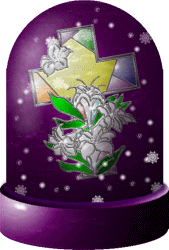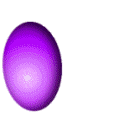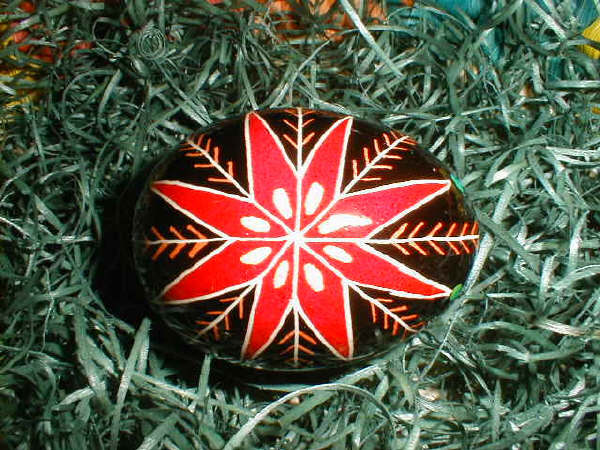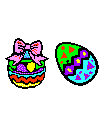 |
 |
Reply
 | |
| EASTER: HOW IT ALL BEGAN 
The name "Easter" probably originated with the names of an ancient goddess. The Venerable Bede first asserted in his book De Ratione Temporum that Easter was named after Eostre (a.k.a. Eastre). She was the Great Mother Goddess of the Saxon people in Northern Europe. Similar "Teutonic dawn goddess of fertility [were] known variously as Ostare, Ostara, Ostern, Eostra, Eostre, Eostur, Eastra, Eastur, Austron and Ausos." Her name was derived from the ancient word for spring: "eastre." Similar goddesses were known by other names in ancient cultures around the Mediterranean, and were celebrated in the springtime. Some were Aphrodite from Cyprus, Astarte from Phoenicia, Demeter from Mycenae, Hathor from Egypt, Ishtar from Assyria, Kali from India, and Ostara, a Norse Goddess of fertility. An alternate explanation has been suggested. The name given by the Frankish church to Jesus' resurrection festival included the Latin word alba which means white. This was a reference to the white robes that were worn during the festival. Alba also has a second meaning, sunrise. When the name of the festival was translated into German, the sunrise meaning was selected in error. This became ostern in German. Ostern has also been proposed as the origin of the word Easter. Many, perhaps most, pagan religions in the Mediterranean area had a major seasonal day of religious celebration at or following the Spring Equinox. Cybele, the Phrygian fertility goddess, had a fictional consort who was believed to have been born via a virgin birth. He was Attis, who was believed to have died and been resurrected each year during the period March 222 to March 25. "About 200 B.C. mystery cults began to appear in Rome just as they had earlier in Greece. Most notable was the Cybele cult centered on Vatican hill ...Associated with the Cybele cult was that of her lover, Attis ([the older Tammuz, Osiris, Dionysus, or Orpheus under a new name). He was a god of ever-reviving vegetation. Born of a virgin, he died and was reborn annually. The festival began as a day of blood on Black Friday and culminated after three days in a day of rejoicing over the resurrection," the Bede noted. Wherever Christian worship of Jesus and pagan worship of Attis were active in the same geographical area in ancient times, Christians "used to celebrate the death and resurrection of Jesus on the same date; and pagans and Christians used to quarrel bitterly about which of their gods was the true prototype and which the imitation." Many religious historians believe that the death and resurrection legends were first associated with Attis, many centuries before the birth of Jesus. They were simply grafted onto stories of Jesus’s life in order to make Christian theology more acceptable to pagans. Others suggest that many of the events in Jesus' life that were recorded in the gospels were lifted from the life of Krishna, the second person of the Hindu Trinity. Ancient Christians had an alternate explanation; they claimed that Satan had created counterfeit deities in advance of the coming of Christ in order to confuse humanity. Modern-day Christians generally regard the Attis legend as being a pagan myth of little value. They regard Jesus' death and resurrection account as being true, and unrelated to the earlier tradition. Religious followers from around the world observe many seasonal days of celebration during March and April. Most are religious holy days, and are linked in some way to the spring or vernal equinox. On that day, the daytime and nighttime hours are approximately equal -- each being 12 hours long. Christianity and other religious associate three themes with the vernal equinox: Conception and pregnancy leading to birth on the winter solstice; victory of a god of light (or life, rebirth, resurrection) over the powers of darkness (death); and the descent of the goddess or god into the underworld for a period of three days. This is such a popular theme among religions that mythologists refer to it as "the harrowing of Hell." Among the Roman Catholic church and Protestant denominations, Easter Sunday falls on the first Sunday after the first full moon after March 20, the nominal date of the Spring Equinox. Its ancient linkages to sun and moon worship are obvious. Many sources state that the starting date of the calculation is the actual day of the Equinox rather than the nominal date of March 20. Easter Sunday can fall on any date from March 22 to April 25. Prior to A.D. 325, Easter was variously celebrated on different days of the week, including Friday, Saturday, and Sunday. In that year, the Council of Nicaea was convened by emperor Constantine. It issued the Easter Rule which states that Easter shall be celebrated on the first Sunday that occurs after the first full moon on or after the vernal equinox. However, a caveat must be introduced here. The "full moon" in the rule is the ecclesiastical full moon, which is defined as the fourteenth day of a tabular lunation, where day 1 corresponds to the ecclesiastical New Moon. It does not always occur on the same date as the astronomical full moon. The ecclesiastical "vernal equinox" is always on March 21. Therefore, Easter must be celebrated on a Sunday between the dates of March 22 and April 25. The Cross is the symbol of the Crucifixion, as opposed to the Resurrection. However, at the Council of Nicaea, in A.D. 325, Constantine decreed that the Cross was the official symbol of Christianity. The Cross is not only a symbol of Easter, but it is more widely used, especially by the Catholic Church, as a year-round symbol of their faith. Easter is at the end of the Lenten season, which covers a forty-six-day period that begins on Ash Wednesday and ends with Easter. The Lenten season itself comprises forty days, as the six Sundays in Lent are not actually a part of Lent. Sundays are considered a commemoration of Easter Sunday and have always been excluded from the Lenten fast. The Lenten season is a period of penitence in preparation for the highest festival of the church year, Easter. Holy Week, the last week of Lent, begins its with the observance of Palm Sunday. Palm Sunday takes its name from Jesus' triumphal entry into Jerusalem where the crowds laid palms at his feet. Holy Thursday commemorates the Last Supper, which was held the evening before the Crucifixion. Friday in Holy Week is the anniversary of the Crucifixion, the day that Christ was crucified and died on the cross. Saturday is a day of mourning for the slain Christ, culminating in the rejoicing of the Resurrection on Sunday. 
CLICK THE CHICK TO GO TO THE NEXT PAGE! CELTIC CROSS BACKGROUND FROM ABSOLUTE WEB GRAPHICS PURPLE LAVA BACKGROUND BY FOREVER AMBER DANCING PEEP FROM JO'S WORLD GLOBE FROM CYBER2000 | | |
|
 First First
 Previous
2-4 of 4
Next Previous
2-4 of 4
Next Last
Last
|
 |
Reply
 | |
| RITES OF SPRING     
NEOPAGANISM: This is a group of religions which are attempted re-creations of ancient pagan religions. Of these, Wicca is the most common; it is loosely based on ancient Celtic beliefs, symbols and practices, with the addition of some more recent ceremonial magic rituals.
Wiccans and other modern-day Neopagans continue to celebrate the Spring Equinox as one of their 8 yearly Sabbats (holy days of celebration). Wiccans recognize eight seasonal days of celebration. Four are minor sabbats and occur at the two solstices and the two equinoxes. The other are major sabbats which happen approximately halfway between an equinox and solstice. Wiccans may celebrate Lady Day on the evening before, or at sunrise on the morning of the solstice/equinox, or at the exact time of vernal equinox.
Near the Mediterranean, this is a time of sprouting of the summer's crop; farther north, it is the time for seeding. Their rituals at the Spring Equinox are related primarily to the fertility of the crops and to the balance of the day and night times. Where Wiccans can safely celebrate the Sabbat out of doors without threat of religious persecution, they often incorporate a bonfire into their rituals, jumping over the dying embers is believed to assure fertility of people and crops. The Spring Equinox is also variantly known as Alban Eilir, Eostar, Eostre, Feast of Annunciation of the Blessed Virgin Mary, Festival of Trees, Lady Day, NawRuz, No Ruz, Ostara, Ostra, Rites of Spring, and the Vernal Equinox.
ANCIENT BRITAIN: Both the solstices and equinoxes were the highly sophisticated preoccupation of the mysterious Megalithic peoples who pre-dated Celt, Roman and Saxon on Europe's Atlantic fringe by thousands of years. The equinoxes were not otherwise celebrated in Britain, until recent years. ANCIENT SAXONS: Eostre was the Saxon version of the Germanic lunar goddess Ostara. She gave her name to the Christian Easter and to the female hormone estrogen. Her feast day was held on the full moon following the vernal equinox -- almost the identical calculation as for the Christian Easter in the west. One delightful legend associated with Eostre was that she found an injured bird on the ground one winter. To save its life, she transformed it into a hare. But the transformation was not a complete one. The bird took the appearance of a hare but retained the ability to lay eggs. ..the hare would decorate these eggs and leave them as gifts to Eostre. Here comes Peter Cottontail! ANCIENT IRELAND: The spring and fall equinox were celebrated in ancient times. A cluster of megalithic cairns are scattered through the hills at Loughcrew, about 55 miles northwest of Dublin in Ireland. Longhcrew Carin is a passage tomb which is designed so that the light from the rising sun on the spring and summer equinoxes penetrates a long corridor and illuminates a backstone, which is decorated with astronomical symbols. ANCIENT GERMANS: Ostara, the Germanic fertility Goddess was associated with human and crop fertility. On the spring equinox, she mated with the solar god and conceived a child that would be born 9 months later on December 21, Yule, the winter solstice. ANCIENT GREEKS: The god-man Dionysios was a major deity among the ancient Greeks. As a god of the spring rites, of the flowering plants and fruitful vines, Dionysios was said to be in terrible pain during winter, when most living things sicken and die, or hibernate. Persephone, a daughter of Demeter, descended into the Otherworld and returned near the time of the spring equinox. This story has close parallels to various Goddess legends, stories of the life of King Arthur, and of Jesus Christ. ANCIENT ROMANS: In about 200 B.C., mystery cults began to appear in Rome just as they had earlier in Greece. Most notable was the Cybele cult centered on Vatican hill ...Associated with the Cybele cult was that of her lover, Attis ([the older Tammuz, Osiris, Dionysus, or Orpheus under a new name)...The festival began as a day of blood on Black Friday and culminated after three days in a day of rejoicing over the resurrection. Attis was born of a human woman, a virgin named Nana. He grew up to become a sacrificial victim and Savior, slain to bring salvation to mankind. His body was eaten by his worshipers in the form of bread...[He was] crucified on a pine tree, whence his holy blood poured down to redeem the earth. The celebration was held on March 25, 9 months before his birth on December 25. In Rome, the rituals took place where St. Peter's now stands in Vatican City. The similarities between the stories of Attis and Jesus are obvious. ANCIENT PERSIA; ZOROASTRIANISM: Various ancient civilizations (Mesopotamia, Sumeria, Babylonia, Elam), circa 3000 to 2000 BC, celebrated new year’s at the time of the spring equinox. No Ruz, the new day or New Year, has been celebrated in the area of modern-day Iran since the Achaemenian (Hakhamaneshi) period over 2500 years ago. It survived because of Zoroastrianism, which was the religion of Ancient Persia before the advent of Islam 1400 years ago. Many religious historians trace the Judeo-Christian concepts of Heaven, Hell, Resurrection. the arrival of the Messiah, and the last judgment to Zoroastrianism. In that faith, the Lord of Wisdom created all that was good and became God. The Hostile Spirit, Angra Mainyu (Ahriman), residing in the eternal darkness created all that was bad and became the Hostile Spirit. This dualistic God/Satan concept is surprisingly close to the views of conservative Christianity today. BAHÁ'Í WORLD FAITH: Naw-Rúz is now a world holiday of the Bahá'í faith. If the equinox occurs before sunset, then New Year's Day is celebrated on that day in the Middle East; otherwise it is delayed until the following day. In the rest of the world, it is always on March 21. It is celebrated with many symbols indicating regrowth and renewal - much like the Christian Easter. Some members follow the ancient Iranian "haft-sin" custom on this day involves arranging seven objects whose name begin with the letter "S" in Persian; e.g. hyacinths, apples, lilies, silver coins, garlic, vinegar and rue. JUDAISM: In its origin, the Passover dinner itself was a spring fertility festival–the unleavened bread coming from the agricultural past of the people and the paschal lamb from its more distant pastoral years. The Bible passages of Leviticus 23:5-8 and Numbers 28:16-18 state that Passover is to be celebrated in the springtime, on the 14th day of the Jewish month of Nissan. The Feast of Unleavened Bread to the Lord is held on the 15th. ANCIENT MAYANS: The indigenous Mayan people in Central American have celebrated a spring equinox festival for ten centuries. As the sun sets on the day of the equinox on the great ceremonial pyramid, El Castillo, Mexico, its western face is bathed in the late afternoon sunlight. The lengthening shadows appear to run from the top of the pyramid's northern staircase to the bottom, giving the illusion of a diamond-backed snake in descent. This has been called "The Return of the Sun Serpent" since ancient times. NATIVE AMERICAN SPIRITUALITY: There are countless stone structures created by Natives in the past and still standing in North America. One was called Calendar One by its modern-day finder. It is in a natural amphitheatre of about 20 acres in size in Vermont. From a stone enclosure in the center of the bowl, one can see a number of vertical rocks and other markers around the edge of the bowl. At the winter solstice, the sun rose at the southern peak of the east ridge and set at a notch at the southern end of the west ridge. The summer solstice and both equinoxes were similarly marked. "America's Stonehenge" is a 4,000 year old megalithic site located on Mystery Hill in Salem, New Hampshire. Carbon dating has estimated the age of some charcoal remnants at 3000 and 4000 years ago. Researchers have concluded that the site was erected either by Native Americans or an unknown migrant European population. The site contains five standing stones and one fallen stone in a linear alignment which point to both the sunrise and sunset at the spring and fall equinoxes. 
CLICK THE CHICK TO GET TO THE NEXT PAGE! EASTER BASKET BINGO WEBSET BY FOREVER AMBER DANCING PEEP FROM JO'S WORLD | | | |
|
Reply
 | |
| SYMBOLS OF THE SEASON 
The Easter Bunny is not a modern invention. The symbol originated with the pagan festival of Eaostre. The goddess, Eaostre, was worshipped by the Anglo-Saxons through her earthly symbol, the rabbit. The Easter bunny has its origin in pre-Christian fertility lore. The hare and the rabbit were the most fertile animals known and they served as symbols of the new life during the spring season. 
The bunny as an Easter symbol seems to have its origins in Germany, where it was first mentioned in German writings in the 1500s. The first edible Easter bunnies were made in Germany during the early 1800s, made of pastry and sugar. The Easter bunny was introduced to American folklore by the German settlers who arrived in the Pennsylvania Dutch country during the 1700s. The arrival of the Oschter Haws was considered childhood's greatest pleasure next to a visit from Christ-Kindel on Christmas Eve. The children believed that if they were good the Oschter Haws would lay a nest of colored eggs. 
The children would build their nest in a secluded place in the home, the barn or the garden. Boys would use their caps and girls their bonnets to make the nests . The use of elaborate Easter baskets would come later as the tradition of the Easter bunny spread through out the country. The Germans brought the symbol of the Easter rabbit to America. It was widely ignored by other Christians until shortly after the Civil War. In fact, Easter itself was not widely celebrated in America until after that time. As with the Easter Bunny and the holiday itself, the Easter Egg predates the Christian holiday of Easter. The exchange of eggs in the springtime is a custom that was centuries old when Easter was first celebrated by Christians. 
From the earliest times, the egg was a symbol of rebirth in most cultures. Eggs were often wrapped in gold leaf or, if you were a peasant, colored brightly by boiling them with the leaves or petals of certain flowers. Originally Easter eggs were painted with bright colors to represent the sunlight of spring and were used in Easter-egg rolling contests or given as gifts. After they were colored and etched with various designs the eggs were exchanged by lovers and romantic admirers, much the same as valentines. In medieval times eggs were traditionally given at Easter to the servants. In Germany eggs were given to children along with other Easter gifts. Different cultures have developed their own ways of decorating Easter eggs. Crimson eggs, to honor the blood of Christ, are exchanged in Greece. In parts of Germany and Austria green eggs are used on Maundy Thursday (Holy Thursday). Slavic peoples decorate their eggs in special patterns of gold and silver. Austrian artists design patterns by fastening ferns and tiny plants around the eggs, which are then boiled. The plants are then removed revealing a striking white pattern. The Poles and Ukrainians decorate eggs with simple designs and colors. A number of eggs are made in the distinctive manner called pysanki (to design, to write). 
Pysanki eggs are a masterpiece of skill and workmanship. Melted beeswax is applied to the fresh white egg. It is then dipped in successive baths of dye. After each dip wax is painted over the area where the preceding color is to remain. Eventually a complex pattern of lines and colors emerges into a work of art. In Germany and other countries eggs used for cooking where not broken, but the contents were removed by piercing the end of each egg with a needle and blowing the contents into a bowl. The hollow eggs were died and hung from shrubs and trees during the Easter Week. The Armenians would decorate hollow eggs with pictures of Christ, the Virgin Mary, and other religious designs. Eggs play an important part in Easter sports. The Romans celebrated the Easter season by running races on an oval track and giving eggs as prizes. Two traditional Easter egg games are the Easter Egg Hunt and the Easter Egg Roll. The rules of an Easter Egg Roll are to see who can roll an egg the greatest distance or can make the roll without breaking it, usually down a grassy hillside or slope. Maybe the most famous egg rolling takes place on the White House Lawn. Hundreds of children come with baskets filled with brightly decorated eggs and roll them down the famous lawn, hoping the President of the United States is watching the fun. 
On Easter morning the children of the house join in a search to locate the eggs that the Easter Bunny had hidden while they where asleep. The searching might continue though out the house with the older children helping the youngest. Sometimes prizes of candy are awaiting the child finding the most eggs. Easter egg hunts can are also part of a community's celebration of holiday. The eggs are hidden in public places and the children of the community are invited to find the eggs. Today, children hunt colored eggs and place them in Easter baskets along with the modern version of real Easter eggs -- those made of plastic or chocolate candy. The exact origins of the jelly bean are lost in time, and only a part of its history is known. Most experts believe the jelly center is a descendent of a Mid-Eastern confection known as Turkish Delight that dates back to Biblical times. The shell coating is an offspring of a process called panning, first invented in 17th century France to make Jordan Almonds. The panning process, while done primarily by machine today, has remained essentially the same for the last 300 years. The French began by rocking almonds in a bowl filled with sugar and syrup until the almonds were coated with a candy shell. Today, large rotating pans do the heavy work, while master confectioners apply their true art in adding the ingredients to create just the right shell. Somehow the two processes made their way to America. Jelly beans quickly earned a place among the many glass jars of "penny candy" in general stores where they were sold by weight and taken home in paper bags. It wasn't until the 1930's, however, that jelly beans became a part of Easter traditions. Over 15 billion jelly beans are enjoyed at Eastertime. If they were lined up end-to-end, they would circle the Earth nearly 3 times. 
CLICK THE CHICK TO GET TO THE NEXT PAGE! CUTE CHICKA WEBSET BY FOREVER AMBER ANIMATIONS FROM JO'S WORLD | | | |
|
 First First
 Previous
2-4 of 4
Next Previous
2-4 of 4
Next Last
Last
|
|
 Free Forum Hosting
Free Forum Hosting